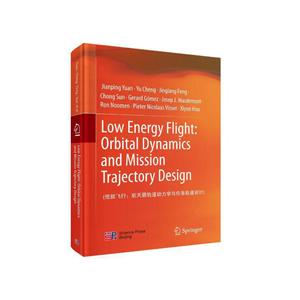扫一扫
关注中图网
官方微博
本类五星书更多>
-
>
湖南省志(1978-2002)?铁路志
-
>
公路车宝典(ZINN的公路车维修与保养秘籍)
-
>
晶体管电路设计(下)
-
>
无头案:雍正暴亡之谜
-
>
基于个性化设计策略的智能交通系统关键技术
-
>
花样百出:贵州少数民族图案填色
-
>
识木:全球220种木材图鉴
低能飞行:航天器轨道动力学与任务轨道设计(英文版) 版权信息
- ISBN:9787030619778
- 条形码:9787030619778 ; 978-7-03-061977-8
- 装帧:圆脊精装
- 册数:暂无
- 重量:暂无
- 所属分类:>
低能飞行:航天器轨道动力学与任务轨道设计(英文版) 本书特色
本书在现代航天动力学的框架下,研究了低能飞行中的轨道动力学问题和任务轨道(转移或者目标轨道)设计问题。旨在用新的方法解决传统的问题,或者对若干亟待解决的新问题展开探索研究,涵盖了以下主题:利用虚拟引力场法进行小推力转移轨道设计,三体系统中基于不变流形的转移问题,天基人工磁场下的编队飞行,以及强不规则小行星附近的轨道力学。
低能飞行:航天器轨道动力学与任务轨道设计(英文版) 内容简介
本书在现代航天动力学的框架下,研究了低能飞行中的轨道动力学问题和任务轨道(转移或者目标轨道)设计问题。旨在用新的方法解决传统的问题,或者对若干亟待解决的新问题展开探索研究,涵盖了以下主题:利用虚拟引力场法进行小推力转移轨道设计,三体系统中基于不变流形的转移问题,天基人工磁场下的编队飞行,以及强不规则小行星附近的轨道力学。
低能飞行:航天器轨道动力学与任务轨道设计(英文版) 目录
Contents
Preface
Chapter 1 Introduction 1
1.1 Low-Thrust Propulsion 3
1.2 Transfer in the Earth-Moon System 4
1.3 Orbital Dynamics Around Irregular Bodies 4
Chapter 2 Continuous Low Thrust Trajectory Design and Optimization 6
2.1 The Virtual Gravity Field Method 6
2.1.1 Introduction[1-25] 6
2.1.2 The Definition of Virtual Central Gravitational Field 7
2.2 Trajectory Design Using the VCGF Method 9
2.2.1 Rendezvous Trajectory Design Using VCGF Method 9
2.2.2 Orbit Interception Trajectory Design Using VCGF Method 14
2.2.3 Mission Applications 15
2.2.4 Conclusion Remarks 24
2.3 Orbital Rendezvous Between Close Near Earth Asteroids Considering the Third Body Perturbation 25
2.3.1 Introduction 25
2.3.2 The Variation of Orbital Elements Caused by the Earth Gravitational Perturbation 27
2.3.3 Orbital Rendezvous Considering the Third Body Perturbation 30
2.3.4 Minimal Fuel Consumption Optimization Using Hybrid Systems 34
2.3.5 Simulation Analysis 36
2.3.6 Conclusions 41
References 42
Chapter 3 Transfer Between Libration Point Orbits and Lunar Orbits in Earth-Moon System 44
3.1 Introduction[1-23] 44
3.2 The Dynamic Model 46
3.2.1 Equations of Motion 46
3.2.2 Change of Coordinates Between the Synodic CR3BP and the Moon-Centred Sidereal Frames 47
3.3 Computation of a Transfer from LPO to a Circular Lunar Orbit 50
3.3.1 Computation of the Transfer Manoeuvre to a Keplerian Ellipse with a Fixed Inclination i 52
3.3.2 Computation of the Departure Manoeuvre: First Approximation 53
3.3.3 Refinement of the Departure Manoeuvre and Determination of P2 55
3.3.4 Computation of the Insertion Manoeuvre at P2 57
3.4 Numerical Results 58
3.4.1 Departing Halo Orbits and Their Invariant Manifolds 58
3.4.2 Selection of the Inclination i1 60
3.4.3 Role of the Angles Between the Arrival and Departure Velocities at P1 and P2 62
3.4.4 The Role of the Orbit on the Unstable Manifold with 64
3.4.5 Varying P1 Along the Manifold Leg 66
3.4.6 Setting P1 at the First Apolune 69
3.4.7 Changing the Sizes of the Departing and the Target Orbits 69
3.5 Conclusions 72
References 73
Chapter 4 Lorentz Force Formation Flying in the Earth-Moon System 76
4.1 Introduction[1-38] 77
4.2 Analysis of the Relative Dynamics of a Charged Spacecraft Moving Under the Influence of a Magnetic Field 78
4.2.1 Modelling Equations and Symmetries 78
4.2.2 Equations of Motion in the Normal, Radial and Tangential Cases 81
4.2.3 Symmetries 82
4.2.4 Equilibrium Points 83
4.2.5 Stability of the Equilibrium Points 85
4.2.6 Zero Velocity Surfaces 89
4.3 Periodic and Quasi-periodic Orbits Emanating from Equilibria 93
4.3.1 Computation of Periodic Orbits Around the Equilibrium Points 93
4.3.2 Computation of 2D Invariant Tori 99
4.3.3 Numerical Results on Periodic and Quasi-periodic Orbits 107
4.3.4 The Normal Case 107
4.3.5 The Radial Case 120
4.3.6 The Tangential Case 125
4.4 Formation Flying Configuration Design 127
4.4.1 Formation Flying Configuration Using Equilibrium Points 127
4.4.2 Formation Flying Configuration Using Periodic Orbits 127
4.5 Conclusions 130
References 121
Chapter 5 1∶1 Ground-Track Resonance in a 4th Degree and Order Gravitational Field 134
5.1 Introduction[1-18] 135
5.2 Dynamical Model 136
5.2.1 Hamiltonian of the System 136
5.2.2 1∶1 Resonance 137
5.3 Primary Resonance 139
5.3.1 EPs and Resonance Width 139
5.3.2 Numerical Results 139
5.4 Secondary Resonance 144
5.4.1 The Location and Width of Hreson2 145
5.4.2 1996 HW1 146
5.4.3 Vesta 151
5.4.4 Betulia 155
5.5 The Maximal Lyapunov Characteristic Exponent of Chaotic Orbits 158
5.6 Conclusions 160
References 162
Chapter 6 Orbital Dynamics in the Vicinity of Contact Binary Asteroid Systems 164
6.1 Summary 164
6.2 Numerical Analysis of Orbital Motion Around Contact Binary Asteroid System 166
6.2.1 Introduction[1-55] 166
6.2.2 Dynamical Model 168
6.2.3 Contact Binary System 1996 HW1 171
6.2.4 Orbital Motion Around the System 181
6.2.5 Conclusions 187
6.3 Orbital Motion in the Vicinity of the Non-collinear Equilibrium Points 188
6.3.1 Introduction 188
6.3.2 Dynamical Model 190
6.3.3 Non-collinear EPs and Their Stability 192
6.3.4 Motion Around the Stable Non-collinear EPs 195
6.3.5 Motion Around the Unstable Non-collinear EPs 201
6.3.6 Conclusions 207
References 208
Appendix A The Primary Zonal and Tesseral Terms Contributing to the 1∶1 Resonance 212
Appendix B The Un-normalized Spherical Harmonic Coefficients to Degree and Order 4 214
References 215
Appendix C The Location of EPs and Resonance Width 216
Appendix D The Second Derivatives of the Potential at the Eps Located at (x0, y0, 0) 218
Appendix E The First and S
展开全部
书友推荐
- >
大红狗在马戏团-大红狗克里弗-助人
大红狗在马戏团-大红狗克里弗-助人
¥3.3¥10.0 - >
罗庸西南联大授课录
罗庸西南联大授课录
¥13.8¥32.0 - >
我从未如此眷恋人间
我从未如此眷恋人间
¥15.9¥49.8 - >
史学评论
史学评论
¥17.2¥42.0 - >
中国人在乌苏里边疆区:历史与人类学概述
中国人在乌苏里边疆区:历史与人类学概述
¥24.0¥48.0 - >
烟与镜
烟与镜
¥18.2¥48.0 - >
上帝之肋:男人的真实旅程
上帝之肋:男人的真实旅程
¥19.3¥35.0 - >
罗曼·罗兰读书随笔-精装
罗曼·罗兰读书随笔-精装
¥40.6¥58.0
本类畅销
-
塞斯纳172飞机与飞行模拟
¥47.6¥68 -
罗尔斯·罗伊斯300型航空涡轮轴发动机培训教程
¥46.5¥56 -
火箭发动机燃烧原理
¥15.4¥48 -
舰载机设计特点与技术性能分析
¥12.2¥36 -
2022图书×抽奖盲袋
¥9.9¥25 -
2023读书月阅读盲盒——天黑,闭眼,刀谁?
¥42.3¥158















